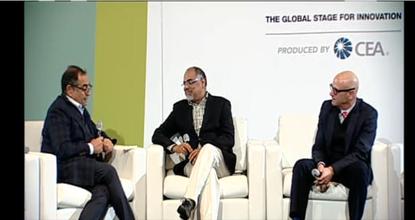CES 2015: Mastercard, Microsoft marketers debate data versus creativity
- 08 January, 2015 12:10

From left: Medialink's Michael Kassan; MasterCard global CMO, Raja Rajamanner; Microsoft North America VP of sales and marketing, Bob Bejan
Marketers are finally realising the dream of reaching the right consumer at the right time and with the right offer thanks to technology and data, according to MasterCard’s global CMO. But value and creativity is vital in ensuring these interactions are successful.
Speaking on a panel during the Marketing and Engagement stream of this year’s International Consumer Electronics Show (CES), MasterCard’s marketing chief, Raja Rajamannar, said triggering the right consumer interaction in real-time has been the holy grail of marketing throughout his 30-year career.
With the ubiquity of mobile devices that allow marketers to reach consumers at the right time and location, along with the ease of communication today, marketers are finally able to achieve that vision, he said.
“Secondly, data and computer science has evolved so much,” Rajamannar told attendees. “It’s like being a kid in a candy store – there is so much that can be done we’ve never been able to do before.”
Rajamannar pointed to the huge volumes of consumer behavioural intelligence generated on Mastercard’s 1.6 billion users worldwide each time a transaction is undertaken.
“That’s big data and it’s a marketer’s dream to dive into that data and make sense of it, to then leverage it and target that right moment with consumers,” he said.
But fellow panellist and Microsoft’s North American vice-president of marketing and sales, Bob Bejan, cautioned against relying purely on data and algorithms to target consumers. He stressed the ongoing importance of creativity in driving “serendipitous moments” that surprise and delight the customer.
“Programmatic buying is an example of that relentless pursuit… of the right time and right message through data. But what’s just starting to creep is in the realisation that you can’t go all the way in there,” he said.
“It’s one thing to find the right person that wants what you’re selling, but if they don’t know who you are because they’ve lost sight of your brand, because you’ve never done anything that’s promoted a serendipitous moment and emotional connection – random or orthogonal – that may raise awareness and perceptions of your brand, you lose the value. The targeted audience you are pursuing gets smaller and smaller because people don’t know who you are.
“That is a serendipitous moment in and of itself, which is worth pointing out, but it also speaks directly to this idea of balance. You can’t lose sight of the emotional connection even as you’re constantly looking to be in the right place, at the right time with the right offer and right price.”
Related: Why creativity wins out over big data
Programmatic advertising: Digital marketing's saviour or real-time headache?
One of MasterCard’s core ingredients in building stronger ties with customers is its ‘priceless’ marketing campaign. Rajamannar said the 17-year-old message’s impact and long-term success comes requires both technology and creativity.
“We have a fantastic advertising platform, ‘priceless’, which cuts through the clutter and creates that connection with the consumer,” he said. “Over the last year, we’ve looked at how we can evolve that to a more holistic marketing, experiential and lifestyle platform where we’re directly reaching out to consumers. It could be prizes, or where we can surprise and delight consumers without asking them to do anything. It’s not about a promotion; we’re trying to change that whole approach.
“Who to connect with and the information we use then comes back to the data.”
Rajamannar admitted it’s “frightening” how much information brands can glean on consumers while still respecting privacy laws, and stressed the need to both be relevant and respectful in how data is used.
“That’s what we’re trying to do – identify the right consumers, see what the next purchase or transaction is going to be, see the location they’re in, and through our merchants, and create an experience for them at that moment in time,” he said.
Over the past year, Mastercard has also worked to evolve ‘priceless’ from an advertising message to something that stretches across all the four Ps of the marketing mix, Rajamannar said. New initiatives include ‘priceless surprises’, giving customers a range of small and large offers for simply using their card.
Personalisation is another reflection of using data effectively, Bejan said.
“If value is perceived by the consumer, the boundary of letting information going, or even being aware of what information is being leveraged, is widened and that tension decreases,” he said. “That relationship will become more true, and resonate.
“Over the next 5-10 years, what will be interesting to see is the compensation component of that value exchange. I think as they become more aware of that, consumers will want to be compensated.”
Follow CMO on Twitter: @CMOAustralia, take part in the CMO Australia conversation on LinkedIn: CMO Australia, or join us on Facebook: https://www.facebook.com/CMOAustralia

